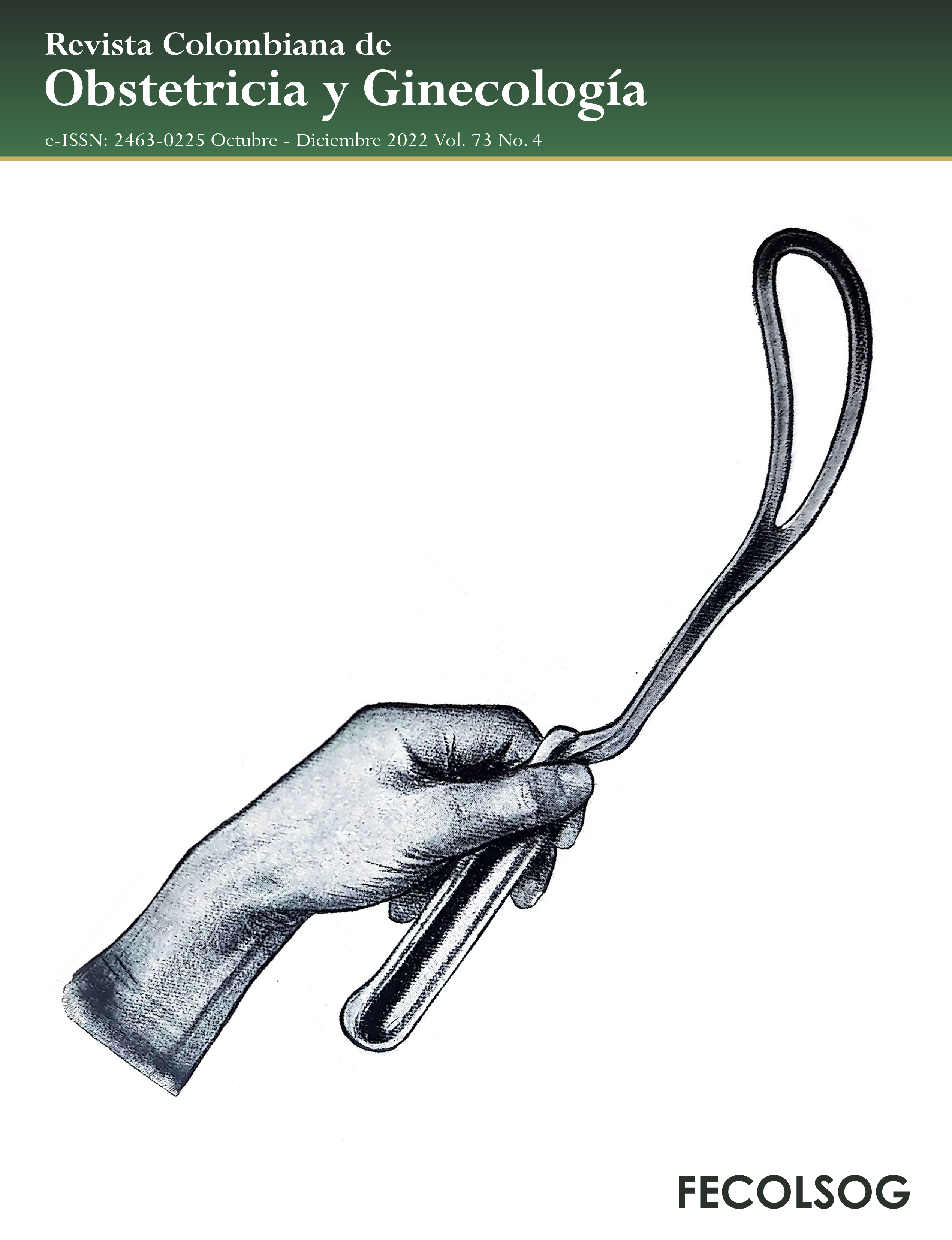Estimated frequency of instrumented vaginal delivery in Colombia be-tween 2015 and 2019. Population registry-based cross-sectional study
DOI:
https://doi.org/10.18597/rcog.3878Keywords:
Obstetric forceps, prevalence, ColombiaAbstract
Objectives: To assess the frequency of instrumented delivery in Colombia and by regions between 2015 and 2019.
Materials and methods: Cross-sectional study based on population registries. Records of women with a gestational age of more than 28 weeks and vaginal delivery were included. Consecutive sampling was used. The information was taken from live birth certificates of the National Administrative Department of Statistics (DANE). Sociodemographic and clinical variables were described. The frequency of instrumented deliveries was calculated and described by year and by department.
Results: Overall, 3,224,218 live birth records were included. Of these 1,719,405 (53.33 %) were vaginal deliveries and 1,468,726 (45.55 %) were cesarean births. At a national level, the frequency of instrumented deliveries between 2015 and 2019 was 36,087 births (1.11 %); Antioquia and Bogotá, D.C. were the places with the highest occurrence, with 16,201 (4.5 %) and 13,686 (2.52 %), respectively.
Conclusions: The occurrence of instrumented vaginal delivery in Colombia is the lowest and tends to diminish. Training of healthcare professionals in this approach during labor must not be abandoned, particularly in Obstetrics and Gynecology training programs. Further studies should be conducted to determine whether the increased adequate use of this technique could contribute to a lower rate of cesarean sections, and also to describe the clinical setting in which its use is safe for both the mother and the fetus. Prospective studies are required to identify the causes leading to the lower use of this obstetric tool as well as the risks and benefits in terms of maternal and perinatal outcomes.
Author Biographies
Nicolás Rozo-Agudelo, Fundación Universitaria Sanitas, Bogotá (Colombia).
Fundación Universitaria Sanitas, Bogotá (Colombia).
Sebastian Camilo Daza-Barrera, Fundación Universitaria Sanitas, Bogotá (Colombia).
Fundación Universitaria Sanitas, Bogotá (Colombia).
References
Liao JB, Buhimschi CS, Norwitz ER. Normal labor: Mechanism and duration. Obstet Gynecol Clin North Am. 2005;32(2):145–64. https://doi.org/10.1016/j.ogc.2005.01.001
Cheng YW, Caughey AB. Defining and Managing Normal and Abnormal Second Stage of Labor. Obstet Gynecol Clin North Am. 2017;44(4):547–66. https://doi.org/10.1016/j.ogc.2017.08.009
Caughey AB, Cahill AG, Guise JM, Rouse DJ. Safe prevention of the primary cesarean delivery This document was developed jointly by the with the assistance of. Am J Obstet Gynecol. 2014;210(3):179–93. https://doi.org/10.1016/j.ajog.2014.01.026
LeFevre N, Krumm E, Cobb W. Labor Dystocia in Nulliparous Women. Am Fam Physician. 2021;2(103):90–6.
Birth OV. Operative Vaginal Birth: ACOG Practice Bulletin Summary, Number 219. Obstet Gynecol. 2020;135(4):982–4. https://doi.org/10.1097/AOG.0000000000003765
Salazar G, Vélez H. Espátulas de Velasco y de Thierry. Med. 2009;68(6):179–83.
Evanson SM, Riggs J. Forceps Delivery. [actualizado el 17 de julio de 2022]. En: StatPearls [Internet]. Treasure Island (FL): StatPearls Publishing; 2022. Disponible en: https://www.ncbi.nlm.nih.gov/books/NBK538220/
Demissie K, Rhoads GG, Smulian JC, Balasubramanian BA, Gandhi K, Joseph KS, et al. Adverse Outcomes: Population Based Retrospective Analysis. Mortality. 2004;329:1–6. https://doi.org/10.1136/bmj.329.7456.24
Yamasato K, Kimata C, Chern I, Clappier M, Burlingame J. Complications of operative vaginal delivery and provider volume and experience. J Matern Neonatal Med. 2021;34(21):3568–73. https://doi.org/10.1080/14767058.2019.1688293
Fong A, Wu E, Pan D, Chung JH, Ogunyemi DA. Temporal trends and morbidities of vacuum, forceps, and combined use of both. J Matern Neonatal Med. 2014;27(18):1886–91. https://doi.org/10.3109/14767058.2014.904282
Qiufeng L, Jie X, Xiahong W, Lixin Y. Changes and analysis of transvaginal forceps delivery rate in primary hospitals in the past 10 years. Ginekol Pol. 2019;90(12):711–6. https://doi.org/10.5603/GP.2019.0122
Medina-Parra J, Eslava-schmalbach J, Montoya L. Characterization of medical malpractice claims against obstetricians affiliated to FEPASDE in Colombian 1999-2014. Rev Colomb Anestesiol. 2018;46(120):112–8. https://doi.org/10.1097/CJ9.0000000000000022
Shwayder JM. Liability in High-Risk Obstetrics. Obstet Gynecol Clin North Am. 2007;34(3):617–25. https://doi.org/10.1016/j.ogc.2007.08.003
Goetzinger KR, Macones GA. Operative vaginal deliver y: Current trends in obstetrics. Women’s Heal. 2008;4(3):281–90. https://doi.org/10.2217/17455057.4.3.281
Departamento Administrativo Nacional de Estadística DANE. Microdatos. [Internet] [consultado el 28 de julio de 2022]. Disponible en: https://microdatos.dane.gov.co/index.php/catalog/MICRODATOS/about
Departamento Administrativo Nacional de Estadística DANE. Estadísticas Vitales - EEVV. [Internet]. Bogotá: DANE; 2019. [actualizado 2020 jul.; consultado 2022 mayo] Disponible en: https://www.datos.gov.co/widgets/kk5wugzm
National Vital Statistics System NVSS. Birth Data. [Internet]. [consultado el 01 de febrero de 2022]. Disponible en: https://www.cdc.gov/nchs/nvss/births.htm
Harrison MS, Saleem S, Ali S, Pasha O, Chomba E, Carlo WA, et al. A Prospective, Population-Based Study of Trends in Operative Vaginal Delivery Compared to Cesarean Delivery Rates in Low- and Middle-Income Countries, 2010–2016. Am J Perinatol. 2019;36(7):730–6. https://doi.org/10.1055/s-0038-1673656
Merriam AA, Ananth CV, Wright JD, Siddiq Z, D’Alton ME, Friedman AM. Trends in operative vaginal delivery, 2005–2013: a population-based study. BJOG An Int J Obstet Gynaecol. 2017;124(9):1365–72. https://doi.org/10.1111/1471-0528.14553
Australian Institute of Health and Welfare. National Core Maternity Indicators, Instrumental vaginal birth. [consultado el 01 de febrero de 2022]. Disponible en: https://www.aihw.gov.au/reports/mothers-babies/national-core-maternity-indicators-1/contents/labour-andbirth-indicators/instrumental-vaginal-birthindicators/instrumental-vaginal-birth
Hubena Z, Workneh A, Siraneh Y. Prevalence and Outcome of Operative Vaginal Delivery among Mothers Who Gave Birth at Jimma University Medical Center, Southwest Ethiopia. J Pregnancy. 2018;2018. https://doi.org/10.1155/2018/7423475
Muraca GM, Lisonkova S, Skoll A, Brant R, Cundif GW, Sabr Y, et al. Ecological association between operative vaginal delivery and obstetric and birth trauma. Cmaj. 2018;190(24):E734–41. https://doi.org/10.1503/cmaj.171076
Cortés H, Escobar E. Parto vaginal instrumentado en el Hospital Universitario San Vicente de Paúl durante un periodo de 5 años (2000-2004), Medellín, Colombia. Rev Colomb Obstet Ginecol. 2006;57(1):27–30. https://doi.org/10.18597/rcog.530
How to Cite
Downloads
Downloads
Published
Issue
Section
License

This work is licensed under a Creative Commons Attribution-NonCommercial-NoDerivatives 4.0 International License.
| Article metrics | |
|---|---|
| Abstract views | |
| Galley vies | |
| PDF Views | |
| HTML views | |
| Other views | |
















